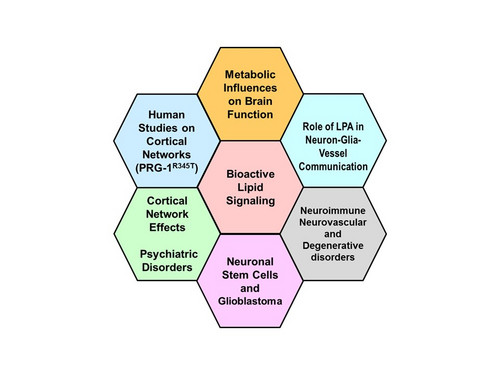Research
Although the influence of environment and age on the body and on the central nervous system is known and the influence of metabolic changes on immune system and on brain function in general is accepted, direct approaches to study these relationships are only rudimentary.
In order to understand these relationships, we work on unraveling molecular neurobiological mechanisms and understanding their translational importance in human diseases. This is based on our scientific understanding that brain diseases can be best understood and treated in the so-called "bottom-up approach". This approach starts with the identification of a molecular target, followed by the analysis of molecular signaling pathways up to systemic analyses in animal models and in human subjects.
The scientific focus of our group is on the role of bioactive phospholipids. These small lipids are potent mediators of biological functions in different organ systems. In the last years we could show that lysophosphatidic acid (LPA) are regulating glutamatergic transmission at cortical synapses and modulate cortical network excitability (Cell 2009; EMBO Mol Med 2016; Dev Cell 2016; Mol Psychiatry 2018) but also modulate axonal cytoskeleton (Neuron 2016; Cereb Cortex 2017). These mechanisms have important pathophysiological roles in psychiatric disorders (Mol. Psychiatry 2018), in stroke outcome but also in successful ageing and life-long preservation of cognitive functions (Fischer et al., in press). Moreover, latest research show that lipid regulation of brain function is modulated by changes in peripheral metabolism, which indeed suggests a novel, systemic body-brain loop in cortical network excitability regulation.
Our methodological spectrum is based on three pillars. Our core pillar consists in molecular biology/protein biochemistry/cell biology methods including live imaging. The second includes electrophysiological measurements and finally, in order to translate our findings on a systemic level, we perform in-vivo analyses of animal models with a strong focus on behavioral analyses.
Overview on molecular mechanisms of synaptic lipid signaling and their translational involvement

